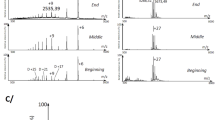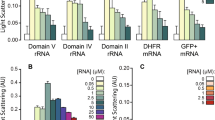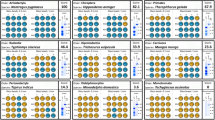Abstract
The infectious form of prion protein, PrPSc, self-propagates by its conversion of the normal, cellular prion protein molecule PrPC to another PrPSc molecule. It has not yet been demonstrated that recombinant prion protein can convert prion protein molecules from PrPC to PrPSc. Here we show that recombinant hamster prion protein is converted to a second form, PrPRDX, by a redox process in vitro and that this PrPRDX form seeds the conversion of other PrPC molecules to the PrPRDX form. The converted form shows properties of oligomerization and seeded conversion that are characteristic of PrPSc. We also find that the oligomerization can be reversed in vitro. X-ray fiber diffraction suggests an amyloid-like structure for the oligomerized prion protein. A domain-swapping model involving intermolecular disulfide bonds can account for the stability and coexistence of two molecular forms of prion protein and the capacity of the second form for self-propagation.
This is a preview of subscription content, access via your institution
Access options
Subscribe to this journal
Receive 12 print issues and online access
$189.00 per year
only $15.75 per issue
Buy this article
- Purchase on Springer Link
- Instant access to full article PDF
Prices may be subject to local taxes which are calculated during checkout






Similar content being viewed by others
References
Prusiner, S.B. Prions. Proc. Natl. Acad. Sci. USA 95, 13363–13383 (1998).
Griffith, J.S. Self-replication and scrapie. Nature 215, 1043–1044 (1967).
Zahn, R. et al. NMR solution structure of the human prion protein. Proc. Natl. Acad. Sci. USA 97, 145–150 (2000).
Lopez Garcia, F., Zahn, R., Riek, R. & Wuthrich, K. NMR structure of the bovine prion protein. Proc. Natl. Acad. Sci. USA 97, 8334–8339 (2000).
Riek, R. et al. NMR structure of the mouse prion protein domain PrP(121–231). Nature 382, 180–182 (1996).
James, T.L. et al. Solution structure of a 142-residue recombinant prion protein corresponding to the infectious fragment of the scrapie isoform. Proc. Natl. Acad. Sci. USA 94, 10086–10091 (1997).
Knaus, K.J. et al. Crystal structure of the human prion protein reveals a mechanism for oligomerization. Nat. Struct. Biol. 8, 770–774 (2001).
Kocisko, D.A. et al. Cell-free formation of protease-resistant prion protein. Nature 370, 471–474 (1994).
Horiuchi, M. & Caughey, B. Specific binding of normal prion protein to the scrapie form via a localized domain initiates its conversion to the protease-resistant state. EMBO J. 18, 3193–3203 (1999).
Welker, E., Wedemeyer, W.J. & Scheraga, H.A. A role for intermolecular disulfide bonds in prion diseases? Proc. Natl. Acad. Sci. USA 98, 4334–4336 (2001).
Feughelman, M. & Willis, B.K. Thiol-disulfide interchange a potential key to conformational change associated with amyloid fibril formation. J. Theor. Biol. 206, 313–315 (2000).
Turk, E., Teplow, D.B., Hood, L.E. & Prusiner, S.B. Purification and properties of the cellular and scrapie hamster prion proteins. Eur. J. Biochem. 176, 21–30 (1988).
Welker, E., Raymond, L.D., Scheraga, H.A. & Caughey, B. Intramolecular versus intermolecular disulfide bonds in prion proteins. J. Biol. Chem. 277, 33477–33481 (2002).
Prusiner, S.B. et al. Further purification and characterization of scrapie prions. Biochemistry 21, 6942–6950 (1982).
Jackson, G.S. et al. Reversible conversion of monomeric human prion protein between native and fibrilogenic conformations. Science 283, 1935–1937 (1999).
Swietnicki, W., Morillas, M., Chen, S.G., Gambetti, P. & Surewicz, W.K. Aggregation and fibrillization of the recombinant human prion protein huPrP90–231. Biochemistry 39, 424–431 (2000).
Venkatesan, P., Liu, Z., Hu, Y. & Kaback, H.R. Site-directed sulfhydryl labeling of the lactose permease of Escherichia coli: N-ethylmaleimide-sensitive face of helix II. Biochemistry 39, 10649–10655 (2000).
McPhie, P. Circular dichroism studies on proteins in films and in solution: estimation of secondary structure by g-factor analysis. Anal. Biochem. 293, 109–119 (2001).
Pan, K.-M. et al. Conversion of α-helices into β-sheets features in the formation of the scrapie prion proteins. Proc. Natl. Acad. Sci. USA 90, 10962–10966 (1993).
Harper, J.D. & Lansburry, P.T. Models of amyloid seeding in Alzheimer's disease and scrapie: mechanistic truths and physiological consequences of the time-dependent solubility of amyloid proteins. Annu. Rev. Biochem. 66, 385–407 (1997).
Caughey, B. Transmissible spongiform encephalopathies, amyloidoses and yeast prions: common threads? Nat. Med. 6, 751–754 (2000).
McKinley, M.P., Bolton, D.C. & Prusiner, S.B. A protease-resistant protein is a structural component of the scrapie prion. Cell 35, 57–62 (1983).
Caughey, B. et al. Normal and scrapie-associated forms of prion protein differ in their sensitivities to phospholipase and proteases in intact neuroblastoma cells. J. Virol. 64, 1093–1101 (1990).
Schlunegger, M.P., Bennet, M.J. & Eisenberg, D. Oligomer formation by 3D domain swapping: a model for protein assembly and misassembly. Adv. Protein Chem. 50, 61–122 (1997).
Cohen, F.E. Protein misfolding and prion diseases. J. Mol. Biol. 293, 313–320 (1999).
Steere, B. & Eisenberg, D. Oligomerization of high-order diphtheria toxin oligomers. Biochemistry 39, 15901–15909 (2000).
Weiss, S. et al. Overexpression of active Syrian golden hamster prion protein PrPc as a glutathione S-transferase fusion in heterologous systems. J. Virol. 69, 4776–4783 (1995).
Acknowledgements
We thank S.B. Prusiner's laboratory for helping us in fermentation of HisPrP(90–231), M. Gingery for electron microscopy, M.R. Sawaya for building the model of the PrPRDX fibril, R.L. Garrell's laboratory for helping us in g-factor analysis, M. Apostol for assistance and P.D. Boyer, T.E. Creighton and A.K. Chamberlain for critical reading of the manuscript. This work was supported by the Howard Hughes Medical Institute and the US National Institutes of Health.
Author information
Authors and Affiliations
Corresponding author
Ethics declarations
Competing interests
The authors declare no competing financial interests.
Rights and permissions
About this article
Cite this article
Lee, S., Eisenberg, D. Seeded conversion of recombinant prion protein to a disulfide-bonded oligomer by a reduction-oxidation process. Nat Struct Mol Biol 10, 725–730 (2003). https://doi.org/10.1038/nsb961
Received:
Accepted:
Published:
Issue Date:
DOI: https://doi.org/10.1038/nsb961
This article is cited by
-
Onset of disorder and protein aggregation due to oxidation-induced intermolecular disulfide bonds: case study of RRM2 domain from TDP-43
Scientific Reports (2017)
-
A review on protein oligomerization process
International Journal of Precision Engineering and Manufacturing (2015)
-
β2-microglobulin forms three-dimensional domain-swapped amyloid fibrils with disulfide linkages
Nature Structural & Molecular Biology (2011)
-
Nutrient uptake in rust fungi: how sweet is parasitic life?
Euphytica (2011)
-
Differences in prion strain conformations result from non-native interactions in a nucleus
Nature Chemical Biology (2010)



